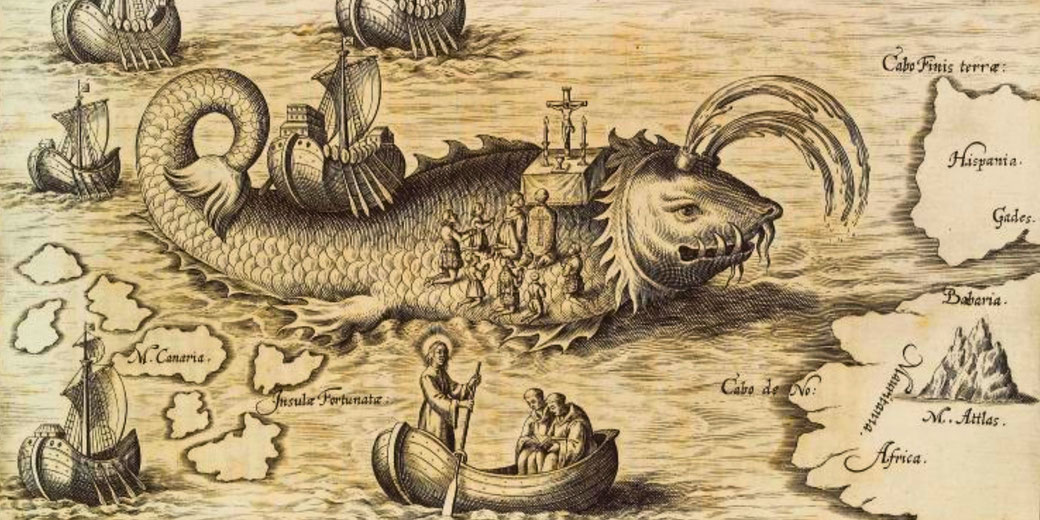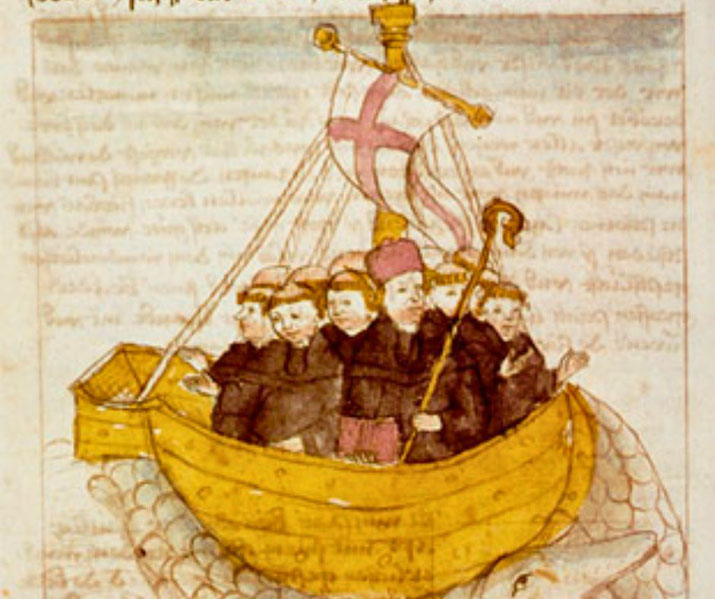Did a 6th century Irish monk reach the Americas before Columbus and the Vikings?

The legend of Saint Brendan the Navigator, one of Ireland's most revered saints, is a compelling blend of history, spirituality, and adventure.
Born in the late 5th century, Brendan's life was shaped by an era of transformation in Ireland, as the country embraced Christianity and began to export its unique monastic culture abroad.
Yet, it is Brendan's purported voyage across the Atlantic, as detailed in the medieval manuscript Navigatio Sancti Brendani Abbatis, that truly captures the imagination.
This epic journey, replete with mystical islands, sea monsters, and divine revelations, has sparked intrigue, controversy, and debate for centuries.
But who was Saint Brendan?
What do we know about his early life and the fantastic voyage that secured his place in legend?
And, how likely is he to be the first European to reach America, centuries before Christopher Columbus and the Vikings?
What do we know about Brendan's life?
Born around 484 CE, Brendan hailed from the rugged, beautiful landscape of County Kerry, on the southwestern coast of Ireland.
His birthplace near Tralee was steeped in the rich heritage of Irish Celtic culture and Christian monastic tradition.
Bred in this fertile environment, Brendan's life was deeply shaped by both these powerful influences.
Raised in a time when Ireland was transitioning from age-old Druidic traditions to Christianity, Brendan was baptized by Saint Erc, a local bishop, who became his guardian and mentor.
His birth during this transformative period placed him among Ireland's first generation of Christians, a factor that would significantly influence his life and work.
At the age of six, Brendan was sent to further his Christian education at a monastery in Killeedy, County Limerick, under the tutelage of Saint Ita.
Known as the 'Brigid of Munster', Saint Ita was one of the most significant figures in early Irish Christianity.
Here, Brendan spent his formative years absorbing religious teachings and learning about the virtues of faith, devotion, and self-denial.
When Brendan reached the age of twenty-six, he was ordained a priest by his foster-father, Saint Erc.
Following his ordination, he traveled across Ireland, studying under various monastic teachers and accumulating extensive knowledge of Christian doctrine, monastic rules, and practices.
This period of his life also exposed Brendan to the rich legacy of Irish oral tradition, which included stories of seafaring expeditions and mysterious lands lying far beyond the horizon.

His dedication to monastic life
Having completed his education, Brendan embarked on a new chapter of his life— one dedicated to monastic service.
In the footsteps of the great Irish missionaries, Brendan adopted a lifestyle characterized by prayer, penance, and a fervent desire to spread the teachings of Christianity.
Around 512 CE, Brendan founded his first monastery in Ardfert, County Kerry. This monastery would grow to become an important center of religious study and devotion, ultimately giving birth to the Ardfert Cathedral.
Brendan's reputation as a spiritual leader attracted many aspiring monks, leading him to establish several other monastic houses throughout Ireland.
Perhaps the most significant of these was Clonfert in County Galway. Clonfert Monastery was founded in 557 CE and some sources suggest it was designed to accommodate over 3,000 monks.
Here, Brendan envisioned a monastic community dedicated to a life of strict observance, fervent prayer, and diligent study.
The monastery became renowned for its rigorous scholarship, helping to secure Ireland's reputation as the 'Island of Saints and Scholars'.
However, Brendan's monastic endeavors were not confined within the borders of Ireland.
His missionary work took him across the sea to places in Scotland and Wales.
Brendan's foreign missions contributed to the spread of Irish monastic ideals, effectively influencing the development of monasticism in Western Europe.
Brendan's monastic life was also characterized by a deep connection with nature, as seen in his voyages.
He undertook pilgrimages, leading his fellow monks in small, open boats called currachs.
These journeys, known as peregrinatio, were spiritual quests, seen as a form of ascetic exile in the wilderness, mirroring Christ’s 40 days in the desert.
It was during one of these that the most famed voyage of Saint Brendan supposedly took place.
Brendan's legendary voyage to the west
The most legendary aspect of Saint Brendan's life is undoubtedly his famed maritime voyage, a journey filled with mystical creatures, heavenly visions, and perilous seas, as detailed in the medieval manuscript, the Navigatio Sancti Brendani Abbatis.
The Voyage of Saint Brendan, as it is commonly known, has fascinated readers for centuries, marking Brendan as one of history's most renowned Christian voyagers.
It was likely composed around 800 CE, centuries after Brendan's death.
The seeds of Brendan's voyage were supposedly sown when a monk named Barinthus visited.
He shared tales of a paradisiacal island, known as the 'Land of Promise of the Saints', which he had allegedly visited.
Inspired by Barinthus's accounts and purportedly guided by an angelic vision, Brendan decided to undertake a quest to find this mystical island.
With a retinue of fellow monks, Brendan set sail in a currach, a traditional Irish boat made of leather hides stretched over a wooden frame.
The journey, which supposedly lasted seven years, led Brendan and his crew through a series of remarkable encounters and divine trials.
These included visits to various islands, encounters with monstrous sea creatures, ethereal birds singing psalms, and a confrontation with demons on a rocky island.
One of the most remarkable episodes of the voyage was the celebrated 'Easter on the Whale'.
According to the account, Brendan and his crew landed on an unknown island to celebrate Easter Mass, only to discover that the island was a gigantic sea creature.
This encounter epitomizes the fantastic nature of Brendan's voyage, underscoring the integration of the natural and spiritual worlds that characterizes Celtic Christianity.

The climax of Brendan's voyage was the discovery of the 'Land of Promise', described as a heavenly, paradisiacal place filled with lush vegetation and abundant fruit.
After staying there for a time, Brendan and his crew were instructed by an angel to return to Ireland, taking with them enough fruit and precious stones to last them their lifetimes.
Upon their return, Brendan is said to have recounted the details of the journey to his fellow monks, who recorded the tale.
This account later became the Navigatio, immortalizing Brendan's voyage for future generations.
How reliable is the written account of this journey?
The Navigatio Sancti Brendani Abbatis or The Voyage of Saint Brendan the Abbot is the primary source of the extraordinary maritime adventures of Saint Brendan.
This Latin text, dating back to at least the 9th century, is not merely a historical account but a mix of religious allegory, monastic ideals, and elements of folklore.
The Navigatio is written in the style of an immram, a genre of old Irish literature describing heroic sea voyages to otherworldly islands.
However, the narrative differs significantly from typical immrama due to its strong monastic moral structure, and it merges Celtic and Christian symbols and motifs.
The text presents an allegorical spiritual journey, mirroring the trials and tribulations of the Christian soul striving for salvation.
The Navigatio comprises numerous fantastical episodes during Brendan's voyage, including encounters with sea monsters, floating crystal pillars, and islands of sheep.
Some interpretations see these as spiritual metaphors—each island representing a different step in the soul's journey towards divine enlightenment.
Other scholars interpret them as echoes of earlier seafaring tales and mythological elements, modified and recontextualized within a Christian narrative.
Beyond its rich narrative and spiritual content, the Navigatio had a profound influence on medieval literature and culture.
It inspired numerous artworks and was copied and translated extensively across Europe, testifying to its broad appeal and impact.
The manuscript also had an enduring effect on geographical understanding, with cartographers including the 'Island of Saint Brendan' on maps as late as the 18th century.
How likely is such a voyage?
The history of Saint Brendan and the account of his legendary voyage are largely based on hagiographic texts and oral traditions.
This has not deterred scholars and enthusiasts from exploring possible historical and archaeological traces linked to Brendan and his epic journey.
As for the voyage itself, archaeological evidence is inevitably elusive, largely due to the mythical nature of the Navigatio narrative.
However, some scholars have sought to link elements of Brendan's voyage with actual geographical locations and natural phenomena.
Various islands, including the Faroe Islands, the Canary Islands, and even parts of Newfoundland in North America, have been proposed as potential correlates for the fantastical islands described in the Navigatio as they bear similarities to the landscapes in the medieval account.
One of the most intriguing attempts to prove the feasibility of Brendan's voyage was the Brendan Voyage, a project undertaken by explorer Tim Severin in 1976.
Severin constructed a traditional currach, similar to the one Brendan would have used, and successfully sailed from Ireland to Newfoundland.
While this expedition could not confirm the historical accuracy of Brendan's voyage, it proved that such a journey would have been technically possible with the maritime technology available during the early medieval period in Ireland.
Why scholars fiercely disagree
Despite the enduring allure of Saint Brendan's tale, it has not been without its share of controversies and debates.
Central among these is the question of the historicity of the Navigatio Sancti Brendani Abbatis.
Is the narrative a factual account of Brendan's voyages, an allegorical religious tale, or purely a work of imaginative fiction?
One school of thought views the Navigatio as a spiritual allegory, similar to many early Christian texts.
In this interpretation, Brendan's journey represents the Christian soul's path towards divine enlightenment, with the islands and encounters symbolizing spiritual trials and revelations.
The fact that Brendan's journey follows a pattern of sevens—a significant number in Christian symbolism—supports this interpretation.
Others propose that the Navigatio is a fusion of Christian allegory and Irish oral tradition, featuring fantastical elements from earlier seafaring tales.
In this view, the historical Brendan may not have undertaken the voyage himself.
Instead, the Navigatio uses his character to frame a narrative that celebrates the Irish monastic spirit of pilgrimage, exploration, and divine pursuit.
However, there are those who argue for the historical validity of the voyage. They propose that the Navigatio, while embellished, may have been based on actual sea voyages undertaken by early Irish monks.
Some even suggest that Brendan or his contemporaries could have reached North America, pre-dating the Viking journeys by several centuries.
These ongoing debates illustrate the challenge of separating historical truth from myth, particularly when dealing with early medieval texts.
While we may never reach a definitive conclusion about the historicity of Saint Brendan's voyage, the controversies and debates it inspires contribute to its enduring legacy and its capacity to captivate the imagination.
What do you need help with?
Download ready-to-use digital learning resources
Copyright © History Skills 2014-2025.
Contact via email
With the exception of links to external sites, some historical sources and extracts from specific publications, all content on this website is copyrighted by History Skills. This content may not be copied, republished or redistributed without written permission from the website creator. Please use the Contact page to obtain relevant permission.





